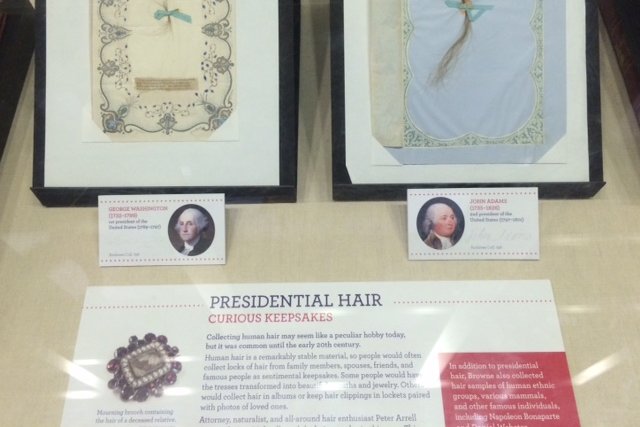
July 02, 2016
 Kevin C. Shelly//PhillyVoice
Kevin C. Shelly//PhillyVoice
A monthlong exhibit has opened at the Academy of Natural Sciences, showing off hair and other objects connected to several American presidents.
Danielle Tretola nearly walked by the Academy of Natural Sciences of Drexel University’s display from its archives linked to United States presidents.
A large album in one corner of a glass case caught her eye.
But it was the other contents of the case – locks of hair from several American presidents and other collectibles, such as Thomas Jefferson’s trove of fossils – that kept her staring.
“Look! There’s John Quincy Adams hair,’ she said to companions.
“It’s a little weird. Definitely a little weird. But very cool,” she said.
And while collecting hair may seem off-putting today, it was commonplace when Philly attorney Peter Arrell Browne (1762-1860) assembled a 12-volume collection of hair, according to Jennifer Vess, an archivist for Academy of Natural Sciences.
Much of the collection consists of mammal hair, especially sheep, because the lawyer was intent on breeding a sheep with better wool, said Vess.
But there’s lots of human hair, too.
Related story: View roaring, moving life-sized dinosaurs at Academy of Natural Sciences
Befitting the holiday, among the locks are a few wisps of Thomas Jefferson’s, as George Washington’s, John Adams’, Andrew Jackson’s and the aforementioned John Quincy Adams’.
Related story: Check out locks of presidential hair in Philly this summer
Vess said the Academy is particularly pleased with Jefferson’s inclusion in the hair collection because he was also a member of the museum, in keeping with his fascination with natural history and fossils, many of which were left to the Academy.
And then, of course, Jefferson was also the chief writer of the Declaration of Independence, the hallmark document drafted in Philadelphia declaring the colonies’ freedom from England.
The urge to collect and classify was part of the Academy’s founding by gentlemen who dabbled in the sciences and natural history.
Browne collected the hair specimens by writing directly to prominent figures or their relatives.
Two people he targeted – but never got – were Ben Franklin and Jefferson Davis, who was Secretary of War when Brown contacted him and went on to lead the Confederacy.
As well as Jefferson, another signer of the Declaration is in the Browne collection, though Charles Carroll’s lock is not on display.
There are also membership cards for Jefferson and Ulysses S. Grant, as well as a letter from Teddy Roosevelt in favor of a law to conserve wild birds.
Jefferson was particularly fond of fossils, mastodons in particular. Many of his fossils are on display, a part of the museum’s archives.
But the third president’s interest in science sometimes led to criticism from the masses during his tenure as president.
In a passage written by Jefferson in defense of his interests, Jefferson wrote: “Our countrymen are too enlightened themselves to believe that ignorance is the best qualification for their service.”
The passage has an interesting resonance today, given some of the issues debated during the presidential primaries.
The exhibit just opened and only runs until July 29. It's included with regular admission.